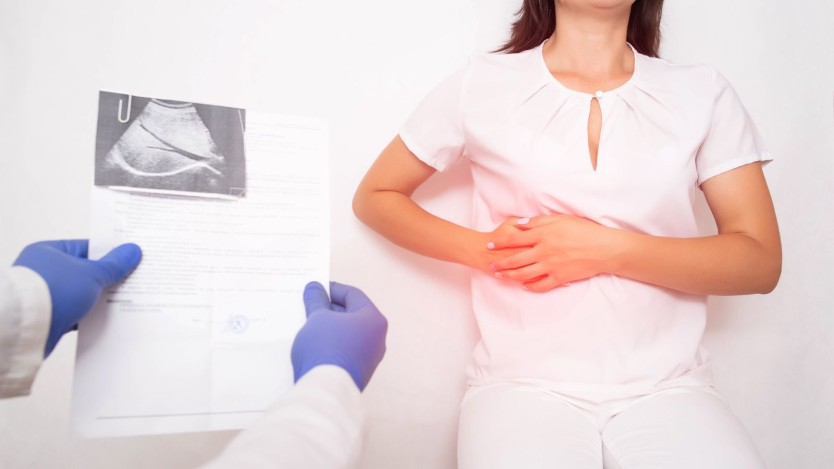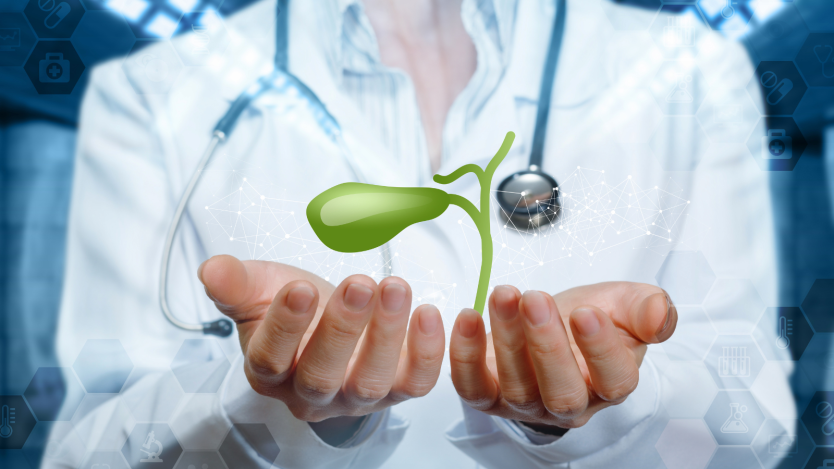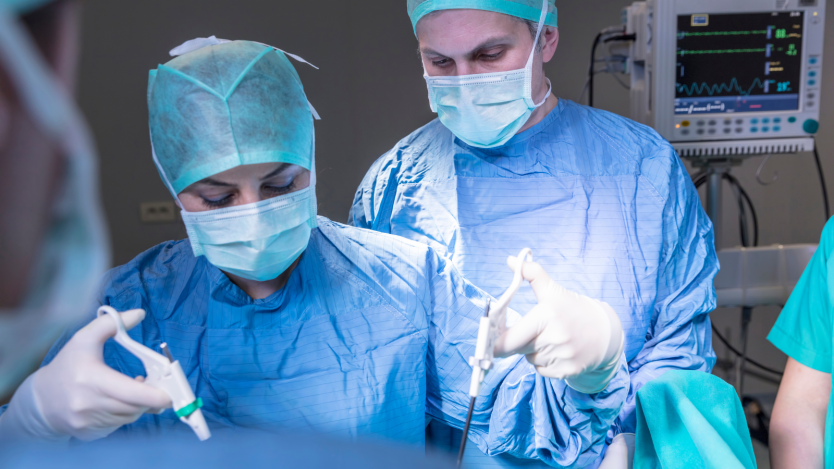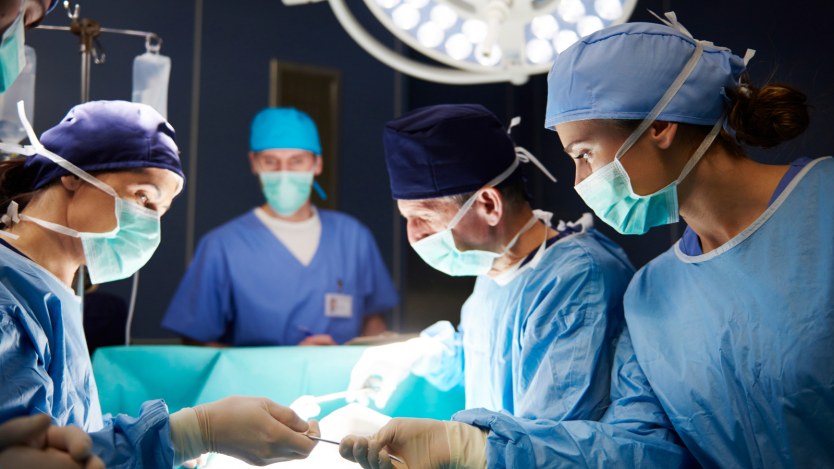Acute cholecystitis: causes, symptoms and treatment

- What is acute cholecystitis?
- Causes of acute cholecystitis
- Symptoms of acute cholecystitis
- Diagnosis of acute cholecystitis
- Complications of acute cholecystitis
- Treatments of acute cholecystitis
- Request a free surgical assessment consultation for gallbladder removal
- Acute cholecystitis is the inflammation and subsequent infection of the gallbladder due to blockage of the bile ducts by cholelithiasis.
- The symptoms of acute cholecystitis are similar to those of biliary colic, but in many cases emergency surgery will be necessary.
- The only definitive treatment to relieve the symptoms of acute cholecystitis is cholecystectomy, either surgically or laparoscopically.
What is acute cholecystitis?
Acute cholecystitis is defined as inflammation and infection of the gallbladder. In most cases, this inflammation and subsequent infection is caused by the occlusion of the gallbladder outlet duct due to the formation of gallstones, also known as gallstones. On other occasions, it is caused by chronic inflammation of the gallbladder that eventually degenerates into an infectious process.

Do you need gallbladder removal surgery?
Request a free and immediate appointment with our specialists in General Surgery
Any patient can develop acute cholecystitis if the necessary circumstances that may favour it are present, as mentioned above. Despite this circumstance, it is more frequent in obese and multiparous women (women who have given birth more than once in their lives) who are over 40 years of age.
In general, acute cholecystitis is included in the category of symptomatic biliary lithiasis with complications, as explained in detail in the text on biliary lithiasis. This indicates that the necessary conditions are met to perform the appropriate surgical intervention to remove the gallbladder depending on the time of diagnosis of acute cholecystitis.
Patients with intestinal disorders such as Chron's disease or irritable bowel disease are more likely to develop acute cholecystitis.
On the other hand, it is also important to know that although the appearance of acute cholecystitis has its own indication for surgical intervention, it is not usually a high-risk surgical process except in people with the following characteristics:
- Patients over 70 years of age
- People with diabetes
- Immunosuppressed patients
In this type of patient, the specialist must assess the feasibility of surgery more carefully due to the risk factors involved, which increase the percentage of systemic infections and complications in the short and medium term.
Nowadays, it is estimated that approximately 25% of cholecystectomies performed are due to acute cholecystitis, in which most of these patients have a previous history of biliary colic.
Causes of acute cholecystitis
The main causes of acute cholecystitis are divided into obstructive, if bile stones or gallstones are involved, and inflammatory causes. Within both causes, obstructive causes are usually the most frequent.

Acute cholecystitis due to obstructive causes
Acute obstructive cholecystitis involves episodes of inflammation and subsequent infection of the gallbladder due to blockage caused by gallstones (stones in the gallbladder). This obstruction of the cystic duct (drainage duct from the gallbladder to the common bile duct or final drainage duct from the liver and pancreas to the intestine) manifests itself as acute pain in the gallbladder area or centre of the abdomen, a feeling of heartburn and even fever due to the infection, which if left untreated would lead to more serious symptoms and a more dangerous situation for the patient's health.
In most cases, acute cholecystitis develops as a result of gallstones blocking the duct leading from the gallbladder.
These gallstones and their obstruction cause retention of gallbladder juices or bile salts inside the gallbladder, causing significant irritation of the gallbladder walls. This favours inflammation and bacterial overgrowth inside the gallbladder and causes the clinical picture of acute cholecystitis.
Acute cholecystitis due to inflammatory causes
As the name of this other cause of acute cholecystitis indicates, acute cholecystitis develops when the gallbladder becomes inflamed. Among the causes of gallbladder inflammation we can differentiate:
- The development of a tumour: the development of a tumour inside the gallbladder results in the gallbladder being unable to drain bile properly, causing the accumulation of fluid and leading to cholecystitis.
- Infections: patients suffering from diseases such as HIV and other viral infections are prone to gallbladder inflammation.
- Gallstones: as in obstructive cholecystitis, gallstones cause bile to accumulate in the organ, leading to the development of the condition.
- Bile duct obstruction: twisting and/or scarring of the bile ducts can lead to inflammation and obstruction of the gallbladder.
- Blood vessel problems: acute cholecystitis may be caused by a serious illness that has damaged the blood vessels, leading to decreased blood flow to the gallbladder, leading to inflammation of the gallbladder.
Symptoms of acute cholecystitis
Patients suffering from acute cholecystitis have usually suffered from biliary colic in the past. The symptoms of acute cholecystitis are similar to those of biliary colic but with some differences:
- Pain. The pain that occurs when one has or presents with acute cholecystitis begins in the upper abdomen or epigastrium and radiates to the right side of the abdomen, just below the ribs in that area. This type of pain is less intense than biliary colic and usually remains constant over time, unlike biliary colic pain, which waxes and wanes over time.
Characteristic of acute cholecystitis is the presence of pain on palpation of the abdomen on the right side when you perform a forced air intake (medical sign known as positive Murphy's sign).

In addition to pain, it is usually accompanied by nausea and vomiting and fever peaks in the first few hours until a sustained fever develops, which decreases relatively little with the use of antipyretics such as paracetamol.
Symptoms of acute cholecystitis are more evident after meals, especially when meals are large or very fatty.
- Nausea and vomiting. As with biliary colic, nausea and vomiting are common, which, together with the other symptoms of acute cholecystitis, will allow the primary care doctor or specialist to diagnose the problem correctly.
- Fever. As it is due to an infection, acute cholecystitis is associated with fever, which decreases relatively little with paracetamol, as mentioned above. This symptom also becomes persistent over time (if you have not seen a doctor beforehand) and the temperature rises.
Diagnosis of acute cholecystitis
As you have seen, the symptoms of the condition are quite uncomfortable and it is advisable to see a specialist as soon as possible.
These signs make the diagnosis of acute cholecystitis clear and evident in most cases, and the presence of the classic exploratory and clinical triad mentioned above is usually very indicative: abdominal pain in the right hypochondrium (positive Murphy) + nausea and vomiting + fever.

Do you need gallbladder removal surgery?
Request a free and immediate appointment with our specialists in General Surgery
Through examination and medical interview, the diagnosis of suspicion is usually evident although it is necessary to confirm it with other complementary tests such as:
- Blood analysis: this test allows us to know the general state of the organism as well as detecting signs of infection and inflammation.
- Abdominal ultrasound: this imaging test helps to identify the state of the gallbladder and bile ducts. It also identifies signs of inflammation or evidence of a blockage in the flow of bile.
- Computed tomography (CT): on certain occasions it may be necessary to perform an abdominal CT scan due to difficulties in the interpretation of the abdominal ultrasound due to the anatomical characteristics of the patients themselves.
Normally the definitive diagnosis is obtained with the analysis of the abdominal ultrasound, which generally allows differentiation between acute cholecystitis and other abdominal entities or diseases.
Don't miss the next point, it is extremely important to detect the development of acute cholecystitis quickly, basically because it is a problem that can worsen very quickly if left untreated, leading to damage to adjacent organs or making treatment more difficult.
Complications of acute cholecystitis
Acute cholecystitis, being an inflammatory and infectious process, should be considered as a septic disease, i.e. potentially life-threatening if adequate treatment is not achieved within the first few days of its onset.
A gallbladder affected by acute cholecystitis is at risk of oedematisation (swelling of the gallbladder due to the accumulation of fluid in its tissue) and thus causing difficulties for the vascularisation or blood supply that nourishes it, which can lead to necrosis (tissue death) of the gallbladder walls over time and without treatment, over time and without treatment, necrosis (tissue death) of the walls of the gallbladder and probable abdominal peritonitis (inflammation of the abdomen due to infection) if the contents of the gallbladder manage to leak into the abdomen as a result of acute cholecystitis.
Fortunately, the frequency of such complications is nowadays minimal.
Treatments of acute cholecystitis
The treatment of acute cholecystitis is eminently surgical. As mentioned above, when a patient diagnosed with gallbladder lithiasis or cholelithiasis develops a complication, such as acute cholecystitis, he or she must undergo surgery to remove the gallbladder.

The timing of the surgery and the type of surgical intervention is what differentiates some of the performances.
Surgical procedures are generally defined according to the duration of the acute cholecystitis, in this case there are two different types:
Urgent surgical treatment
When we talk about urgent surgical treatment, we are referring to the process carried out in cases of acute cholecystitis during the first admission.
This type of action is defined as the treatment of patients with acute cholecystitis of less than 2 days' duration who must undergo surgery during the first 48 hours of hospitalisation. During this waiting time, patients should be administered sera, antibiotics and antipyretics such as paracetamol or similar.
Medical treatment and surgery
In contrast to the previous case, medical treatment and surgical intervention is only performed on patients with acute cholecystitis who do not respond well to initial treatment during the first 48 hours, or suffer complications.
The rest of the patients are operated on a second elective admission 6-8 weeks after the first admission.
On the other hand, we can differentiate between two types of surgical techniques used for gallbladder removal.
Types of intervention to remove the gallbladder with acute cholecystitis
When it comes to gallbladder removal, the specialist can resort to 2 main treatment options. This choice will always depend on the particular characteristics of each patient and the search to minimise risks and increase the success of the operation. These two techniques are as follows:
- Open cholecystectomy: this is the conventional surgery used to remove the gallbladder. During this operation, an incision is made in the abdomen on the upper right side (the area where the gallbladder is located), through which the specialist proceeds to reach the location of the gallbladder and then to remove it. The surgical procedure ends with the closure of the abdominal wall with stitches.
Open gallbladder removal surgery lasts between 30 - 90 minutes and the hospital stay can last from 1 to 4 days. As for the recovery period, it is possible to return to normal after 1 - 2 months.

To solve the problems caused by acute cholecystitis, specialists tend to perform laparoscopic cholecystectomy more frequently.
- Laparoscopic cholecystectomy: this type of minimally invasive procedure is defined as a surgical procedure that allows access to the interior of the abdominal cavity by introducing 2 or 3 surgical instruments in the form of a rod, one of them equipped with an optical lens, through 2 or 3 small incisions in the abdominal wall in order to dissect and remove the gallbladder without the need to open the abdominal wall in a larger incision.
Laparoscopic gallbladder removal surgery has a slightly longer intraoperative duration of 1-2 hours. However, the hospital stay is reduced to 1-2 days and the estimated total recovery time is only 5-10 days.
Interestingly, specialists tend to perform laparoscopic cholecystectomy more frequently, although sometimes it is not possible due to the specific characteristics of each patient and the disease in question, in this case acute cholecystitis.
Request a free surgical assessment consultation for gallbladder removal
If you are thinking of solving the problems caused by acute cholecystitis and you think that the best option is to resort to one of the gallbladder removal surgeries. You can contact our patient service team and request a surgical assessment consultation with our specialists in your city, either by calling at +34 91 141 33 56, filling in the contact form or by clicking below:

Do you need gallbladder removal surgery?
Request a free and immediate appointment with our specialists in General Surgery
Medical disclaimer: All the published content in Operarme is intended to disseminate reliable medical information to the general public, and is reviewed by healthcare professionals. In any case should this information be used to perform a diagnosis, indicate a treatment, or replace the medical assessment of a professional in a face to face consultation. Find more information in the links below:
